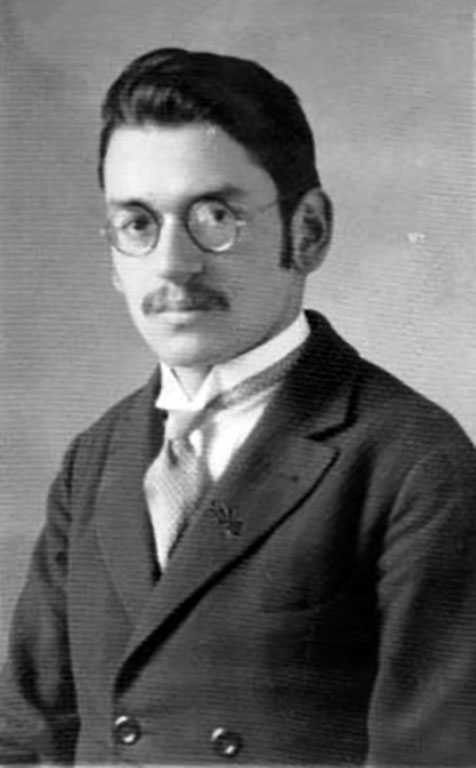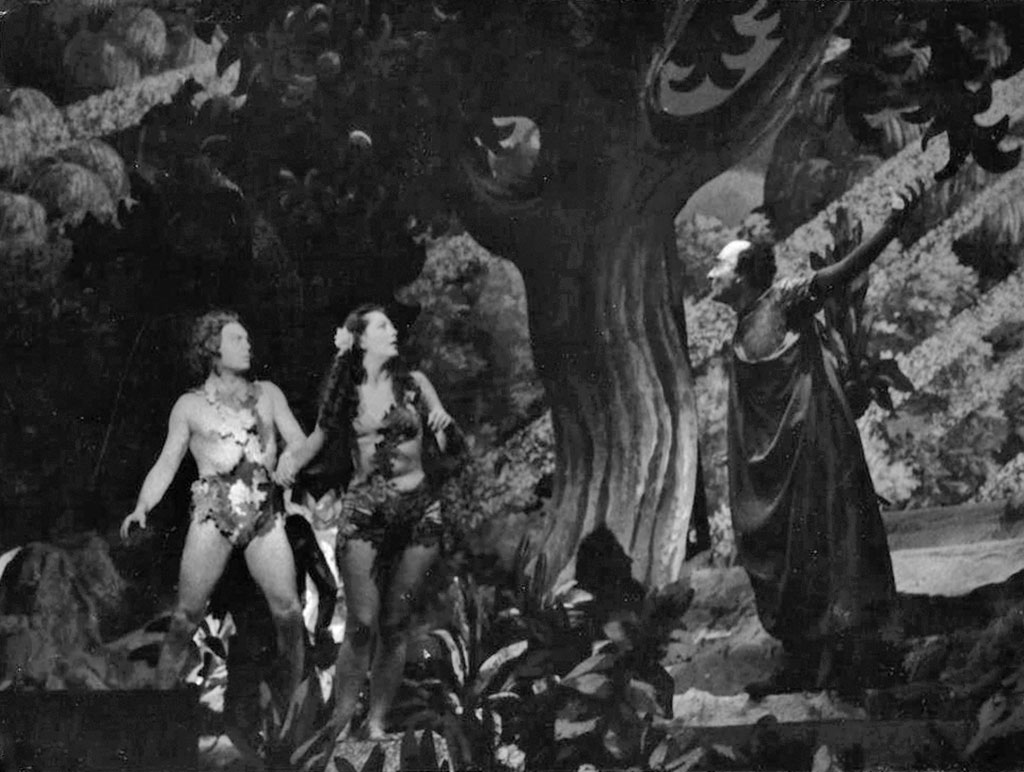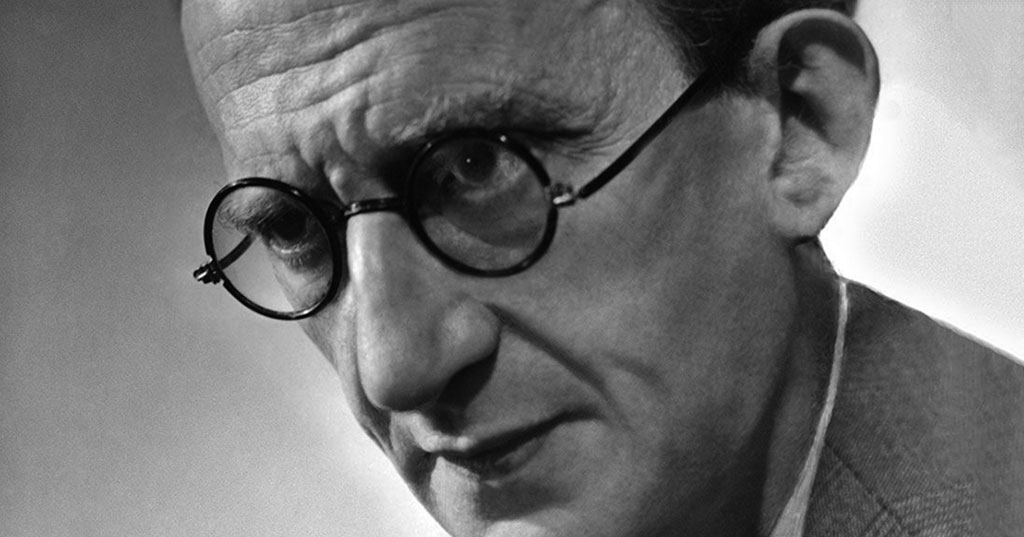Archives 2023
Géza Balogh: Productions of The Tragedy of Man at the National Theatre During and After Dictatorships
Az ember tragédiája (The Tragedy of Man), born at the end of the period of general despair over the fall of the 1848–49 Revolution and War of Independence and at the beginning of the Austro-Hungarian Compromise bringing about a decade of development, is the most well-known work of Hungarian dramatic literature abroad.
Imre Madách penned the first version of the drama titled Lucifer in 1852, during his imprisonment for hiding freedom fighter János Rákóczy, who had been sentenced to death, and wrote a second version between 1856 and 1857. He himself recorded starting The Tragedy on 17 February 1859 and he finished the work nearly a year later, on 20 March 1860.
The dramatic poem considers history in 15 scenes, raising the universal questions of the past and future of mankind, wrapped around the figures of the first human couple, Adam and Eve, and ever-sceptical Lucifer. The deeply philosophical work is customarily listed with such masterpieces of world literature as Milton’s Paradise Lost, Goethe’s Faust and Ibsen’s Peer Gynt. The Tragedy of Man is one of the hardest works to decipher in Hungarian literature and the past 136 years saw several stage interpretations of it.
It premiered on 21 September 1883 at the National Theatre in Budapest. It was directed by Ede Paulay with actors Imre Nagy as Ádám, Mari Jászai as Éva and László Gyenes as Lucifer. The incidental music was composed by Gyula Erkel, and Adam’s costumes and the sets were designed by Ede Paulay, too.
On the initiation of playwright Miklós Hubay, the then president of the Hungarian Writers’ Association, the Hungarian Drama Day has been celebrated on 21 September, the premiere of The Tragedy of Man, since 1984.

(source:wikipedia.org)
Every dictatorship regarded Madách’s dramatic poem as dangerous. When Antal Németh directed it at the Hamburg Staatliches Schauspielhaus in 1937, the Admissions Committee wanted it banned, because it considered the Phalanstery Scene an open attack on the idea of national socialism. It relented after a lengthy debate, on condition that the ominous Scene XII include inscriptions in Cyrillic as a reference to the Soviet Union.[1] The communist one-party state did not dither as much: it simply commanded the play off the stage.
After 1945, it re-entered the stage with a bit of delay during the coalition period, on 26 September 1947, directed by Béla Both, with the set designed by Mátyás Varga, costumes by Teréz Nagyajtay, and new music composed by Sándor Veress, It had two alternate casts: Adam was played by Lajos Básti and Ferenc Ladányi, Eve by Margit Lukács and Éva Szörényi, Lucifer by Tamás Major[2] and Lajos Rajczy. (Subsequently, both Samu Balázs and director Béla Both debuted as Lucifer.) The reason the premiere was delayed for two whole seasons after the “liberation” is suggested by Tamás Major’s foreword in the production’s brochure: “Tibor Barabás’[3] treatise in this booklet sheds light on the outlook and societal concept of Madách’s work and also explains why it has taken so long to interpret properly and to stage The Tragedy of Man in the manner it truly deserves.” Though Tibor Barabás’ essay fails to provide a clear reason, it is the first to mention the subsequently oft-used excuse, “Despite its optimistic ending, The Tragedy of Man is a problem piece, the problem being its outlook.” Barabás suggested it was pessimistic because of the crushing of the 1848 Revolution and War of Independence, and then proceeded to defend the dramatic poem, pointing out how progressive the author’s historical and visionary thinking was.
The critical response was all-encompassing, from enthusiastic celebration to outright rejection. Positive reviews pointed out how the current production returned to the true (?) Madách, in contrast with past, arbitrarily abridged, versions. They highlighted the ardent passion of the Paris Scene and welcomed the restoration of the Second Prague Scene.[4]
Béla Both, director of this, by no means significant, production wrote in the brochure, “The National Theatre’s renewal of The Tragedy will, no doubt, also resurrect its cult, which is both useful and desirable for our literature and theatre culture.”[5]
Béla Both was not the only one to mispredict hugely the play’s future.
The renewed production of 1947 ran for 89 nights and was then removed from the National Theatre’s repertoire for a long time. For four years, there was not a word about Madách’s work. The tacit code of dictatorships is understood to have a rule that says what we don’t talk about does not exist.

In 1952, József Waldapfel, a profoundly Marxist literary historian, who nonetheless happened to be a Madách fan, was the first to dare to publish an essay, resuscitating hopes that the greatest Hungarian national tragedy might soon have a new life on the stage. The introduction reads like this, “To the best of my knowledge, the Madách problem is one of the issues concerning the assessment of Hungarian literary tradition that is surrounded by the greatest uncertainty and commotion, with people from many sides calling for clarification.”[6] He did not hide the fact that he intended to decide as soon as possible the debate on who owned Madách. Did he belong to the “reactionaries” or to “us”, who could rely on the undisputed expert authority of the likes of János Arany or Maksim Gorky? Waldapfel had a good understanding of how the top officials of the one-party state thought: reference to a Soviet writer of authority meant the battle was half won, even if the reference could not be scientifically corroborated. The lengthy essay concludes as follows, “… I think we’ll soon have to reach a stage where The Tragedy of Man can be played again in a production that allows the play’s treasures to shine bright, and to show its hitherto always-falsified fighting message. […] The new production must be preceded by very thorough preparations, which will require artists and scientists to work closely together.”
Yet, one had to wait another two years for Madách’s work to be published by Szépirodalmi (Belles Lettres) Publishing House. The wall of silence was broken by the Budapest-based Madách Grammar School student acting group, which performed The Tragedy on seven occasions[7] at the Small Chamber of the Music Academy in 1954. The premiere and subsequent performance were attended by the era’s cultural crème de la crème, ranging from Zoltán Kodály to Bence Szabolcsi[8], from László Bóka[9] through Zsigmond Remenyik[10] to Deputy Minister Magda Jóború[11].

“Beyond compulsory politeness, the press welcomed the performance with the enthusiasm that the artistic feat and aesthetic value commanded”, wrote Tamás Koltai[12] in his book analysing the theatrical career of The Tragedy. There was a considerable media response in which the daily Magyar Nemzet was the only paper to criticise the imposed silence in a daring article: “What happened is essentially that teachers and students at Madách Grammar School did what the audience expects the National Theatre and our other theatres to do: they staged Madách’s highly controversial work and thus took the first step toward fully recognising and duly acknowledging one of the greatest treasures of our progressive tradition.”[13]
The production designed to be monumental at the National Theatre was directed by three persons: Endre Gellért, Tamás Major and Endre Marton. An indication that the team would take joint responsibility for the production. The dazzling “realistic” period costumes were designed by Gusztáv Oláh, Director General and also Set and Costume Designer of the Opera House. Again, the leading roles were played by two alternating casts: Lajos Básti and Ferenc Bessenyei played Adam, Margit Lukács and Éva Szörényi played Eve (i.e. the actresses playing the same role in the 1947 production), and Tamás Major and László Ungvári played Lucifer. The press covered the long-awaited major event extensively and with due reverence. With one exception: the Communist Party’s central paper chose to ignore it for the time being. István Hermann, a philosopher in György Lukács’[14] circle, published a counter-opinion piece: Lukács and his students had long held reservations about Madách’s play, and took the opportunity to detract it. Instead of treating the play as a masterpiece, Hermann’s review is about “a problem piece that contains fragmented assets and is, therefore, hard to play”.[15]


This was but a prelude to the manoeuvre aimed at banning The Tragedy again. On one occasion, the people’s wise leader, Mátyás Rákosi[16] saw the performance in person. And threw a tantrum in the Manager’s office during the intermission, proclaiming the subsequently oft-quoted sentence “you people are lucky that I hate to see artists in prison!” In short, he personally banned the piece that he thought was detrimental to the ideological development of the masses. But it had been played to full houses on thirty-three occasions since its premiere, so on account of that Major, who was a Central Committee member, later managed to cajole him to authorise three performances a month on average.

But the war was not over yet. At the end of March and at the beginning of April, the daily Szabad Nép published György Lukács’ “decades-old counter-opinion” in two parts, launching a vigorous attack on Madách’s pessimism, along the lines of Hermann’s opinion piece. The Marxist scholar juxtaposed János Erdélyi’s opinion[17] and that of János Arany, pointing out that “Madách’s work attained the height of its success during the Horthy era”. To him, a comparison with Faust did not demonstrate that one was on a par with the other or “even above it ideologically and artistically”. On the contrary: “Madách’s basic concept is flawed in that it overgeneralises… and intends to rise on the wings of generalisation so high as to have the destined overall tragedy of mankind answer his specifically Hungarian question.”[18]
Whatever one thinks of György Lukács’ intentions and candour, his opinion delivered the penultimate stab that would seal the poem’s fate for the 1950s. That last stab came in the form of an article in Irodalmi Újság (Literary Journal) by Sergey Krushinsky[19] a month later, taken over from Pravda, in which Krushinsky challenged an article titled The Situation of Hungarian Theatre Today, published in Sovietskaya Kultura. The contested article had been audacious enough to lavish words of acknowledgement on the performance of The Tragedy of Man at the National Theatre, “attributing to it virtues it does not have in reality”. Krushinsky proceeded thus: “The play’s heroes traverse the ages to reach the conclusion that man’s struggle is pointless. ‘There is wasteland all around’ is the basic concept of the work. The piece rightly criticises Egypt, Rome, Byzantium and the bourgeois establishment, but the problem is the author wants to show that man will not be able to organise society sensibly at any point in future either.
The flawed basic philosophy of the piece doomed the theatre’s efforts to fail. Brilliant though Madách’s strophes may have been in their outward appearance, and much as the directors and actors/actresses may have excelled in implementing their tasks with great talent – all their ado can not turn a lie into truth.”[20] The dramatic poem was re-staged in 1955, but it could only be seen again in the aftermath of the crushed October 1956 Revolution, as of March 1957. Due to the huge interest, it was also performed on the Margaret Island Open Air Stage and on the Tchaikovsky Park Stage in the Kőbánya District of Budapest during the summer.
Three years later, in summer 1960, Major came up with a brand new concept. He would stage the work during the Szeged Open Air Games, and in the autumn, as a morality play at the National Theatre. In an interview, he promised to “rid Madách’s work finally of the incense-smoked spin that has tarnished it… Our starting point will be Madách, this authentic and peculiarly deist-decabrist genius. It would be a mistake to downplay or lie either about his faith or about his progressive revolutionary outlook.”[21] The result of this novel, though still ideology-driven statement was a surprising – turned – laugh-out-loud concept of trying to place the people in the play’s focus. Detractors of Major’s inventive ideas would keep talking about the London police crowd-shooting scene for years, along with the Lord’s portrayal that was supposed to “rid the work in one fell swoop of the mysticism in which bourgeois theatre shrouded the liberal Madách’s deism that was different from the faith of the Catholic Church in God and also from other dogmatic creeds.[22] It was with this dubious production that the National Theatre marked the one thousandth performance of the play on 7th April 1963.
The play was re-staged next on the one hundredth anniversary of Madách’s death, again under Major’s direction, in 1964. Rehearsals began in the condemned Lujza Blaha Square National Theatre building, which would be blown up by a Hungarian People’s Army technical team in March 1965. The tearing down of the main walls put an end to one of the most shameful events in the history of Hungarian theatre.
The production premiered in the new interim National Theatre facility, i.e. Radius Cinema in Nagymező Street (which used to be, and is again today, the Thália Theatre). This facility had served as a host theatre for some time by then and became the home of the National Theatre for two seasons during the reconstruction project. The summer of that year saw the start of the full overhaul of the Sándor Hevesi Square (then Izabella Square) building, with the idea that it would serve as the next home for the troupe until the new National Theatre was built.

at Szeged Open-Air Festival in 1960 (source: tiszataj_1980_008)
The director published a visionary essay in the jubilee programme brochure in which he postulated what were by then his frequently used Brechtian arguments against the “academic” interpretation of the classics. The key feature of the production was the set designed by Endre Bálint[23] which, contrary to the earlier “period” props, was now devoid of any specific historical reference. The costumes were made of leather, inspired by the King Lear costumes used during a recent visit by the Royal Shakespeare Company. The director sought to emphasise a break with his past endeavours by completely recasting the production: Adam would be played by Imre Sinkovits[24], Eve by Hédi Várady, Lucifer by György Kálmán.

(photo: Éva Keleti, source: mandadb.hu)
Again, some of the reviews were enthusiastic and acknowledging, and some remained negative. Péter Rényi, who had amply criticised Major’s earlier direction of The Tragedy, now declared under the protection of Kádár’s “liberalism” that gone were the days when “criticism of the Phalanstery could be turned against our reality. […] The artistic tragedy of The Tragedy has always been that it became great in an age when high art in the theatre meant either lofty rhetoric – e.g. in the spirit of Schiller – or the perfect illusion of reality, i.e. true-to-life reproduction as practised by naturalistic theatre.”[25] Tempura mutantur – or so it might seem.
László Vámos, director of the next production of the dramatic poem in 1983 and Artistic Director of the National Theatre from 1982 to 1990 wrote in 1987, two years before the fall of the one-party state: “Having a New National Theatre is a cause for not only Hungarian theatre, but for our whole socialist culture. The new theatre must belong not only to the National Theatre, but to Hungarian theatre in general[26].
But it would take a lot of water under the bridges of the Danube until the long-awaited National Theatre would be completed in Soroksári Road. In March 2002, The Tragedy of Man premiered as part of the inauguration ceremony, directed by János Szikora[27]. Adam was played by József Szarvas, Eve by Vera Pap, Lucifer by Róbert Alföldi. The reviews reflected the intense attention that matched the importance of the event, but the majority were negative about the performance. Interestingly, a majority of the critics compared the production that was intended to exude hypermodernism to the Meiningenistic tradition set by the very first premiere in 1883. Tamás Koltai wrote that “its concept completely vindicates The Tragedy-Vaudeville. expressing at the same time the low-brow standards of our age, and the high technical standards of the National Theatre.”[28] A sarcastic hint that, more than anything else, the director sought to maximise the utilisation of the new stage’s cutting-edge technology. By contrast, the director did have a message beyond the technology, mostly expressed by reinterpreting the roles of Adam and Eve. Péter Molnár Gál[29] wrote of that as follows: “Szikora lifted the leading roles out of their set contexts, i.e. challenging the idea that Adam would be played by the troupe’s hero, Eve by the naïve heroine, and Lucifer by the scheming villain. A reference to the idea that this time, the main characters of the piece were played by ordinary – or if you will, “little” – people. Katalin Metz’s review defends Szikora’s concept, pointing out that “he only uses the new theatre’s hypermodern stage technology very selectively and sparingly, i.e. to the extent justified by the historical context, the idea presented, and the stage situation. Even when he injects lots of anachronisms into the flow of the performance, a highly risqué technique for a director, he manages to do so without turning it into an exercise per se.[30]

The latest renewal of Madách’s dramatic poem in 2018, and the directorial concept of Attila Vidnyánszky[31], impose a huge task on everyone involved, including all the players and also the spectators seated on the stage-turned-arena.
The production is both puritanical and monumental, i.e. festive and everyday, at the same time. It starts out like a church service. The actors / actresses explain some of the locations, such as the site of the first scene, along with a few of the author’s instructions that they find important. All the players are on stage the whole time, reciting Madách’s poem. The text becomes a montage during the performance. Some sentences are uttered several times, some by a chorus, some consecutively, some in canon, some overlapping and outbidding the others.

Then the Lord’s Voice is heard, interpreted by Imre Sinkovits. There is a mystical, transcendent quality to that. Sinkovits stands for more than himself: he represents the past. His voice evokes his trials and tribulations in the spectators’ minds. He wasn’t just a hero on stage. His life merged with his roles in the Hungarian spectators’ consciousness. He is the National Theatre. He stands for tradition. His virtual presence extends the scope of the performance to its past and to its roots.
Everyone in this community can be Adam, Eve, Lucifer, God, and man. Lucifer is played by the largest number: nine actors pass the baton to and fro. They vary in age, they are old, young and middle-aged. What we see of the story as it unfolds through history is conjured up by Lucifer. The actors do not play a role, they represent behaviour patterns instead. They think together. They comment on the ideas raised, engaging in a passionate debate. To the extent of a few scenes, they embody a role, they “live” certain situations, or they argue like Brecht’s actors, yet they never focus solely on their own role, but on the whole work and their place in it.
Aurél Kárpáti’s words about Hamlet from over ninety years ago apply also to Madách’s play: the secret to Madách’s work, too, is the secret of a genius. It is inscrutable. “We may keep undoing and unravelling the threads of the fabric of his tragedy, but the enigmatic pattern into which the genius wove his magic for all time can never be wholly deciphered.”[32]
The National Theatre’s 2018 production of The Tragedy represents yet another impressive attempt at deciphering the magic; it clearly suggests that this much-criticised and long-banned masterpiece is, after all, optimistic.
English translation by László Vértes
Published in Hungarian: Szcenárium, February 2019
[1] The production premiered on 15th April 1937, translated by Jenő Mohácsi Jenő, with Werner Hinz (Adam), Ehmi Werner (Eve) and Robert Meyn (Lucifer) in the leading roles, and was eventually performed thirty times. It is interesting to note that the play had been staged in a foreign language for the very first time in 1892 in this very town.
[2] Actor and director Tamás Major (1910–1986) was Manager of the National Theatre from 1945 to 1962. At that point, he was demoted to Head Director, a position he held until 1978. He was a decisive figure in post-WWII Hungarian theatre life.
[3] Writer and journalist Tibor Barabás (1911–1984) was Column Manager of the daily Szabad Nép in 1946, then became Secretary General of the Writers Association. He used fiction as a vehicle to promote communist ideology.
[4] The Second Prague Scene was cut already from the 21st September 1883 premiere, directed by Paulay.
[5] Pesti Műsor, 1947, Issue 39.
[6] József Waldapfel (1904–1968): Madách. Irodalomtörténet (Literary History) 1952, Issue 1.
[7] No further performance was permitted.
[8] Bence Szabolcsi (1899–1973) was a scholar of music, a founding father of the modern science of music.
[9] Poet, writer and literary historian László Bóka (1910–1964) became Secretary of State for Public Education as of 1947. He belonged to the third generation of literary journal Nyugat’s (West) authors.
[10] Novel writer and playwright Zsigmond Remenyik (1900–1962) was silenced in the early 1950s.
[11] Teacher, communist cultural policy expert and librarian Magda Jóború (1918–1982) was Deputy Minister for Education between 1950 and 1958, then became Director General of the National Széchényi Library.
[12] Tamás Koltai (1942–2015) was a theatre critic and newspaper editor. Work cited: Az ember tragédiája a színpadon (The Tragedy of Man on the Stage, 1933–1968). Kelenföld Kiadó, 1990. p. 189.
[13] László Lontay (1920–1975): Gimnazisták (Grammar School Students). Magyar Nemzet, 7th April 1954.
[14] Philosopher and scholar of aesthetics György Lukács (1885–1971) was People’s Commissioner in charge of Public Education in 1919. He emigrated after the fall of the Hungarian Soviet Republic, returned in 1945. He was Minister of Culture in Imre Nagy’s government. Retired from public life in 1957.
[15] István Hermann (1925–1986): Madách a Nemzetiben (Madách at the National Theatre). Művelt Nép, 6th February 1955.
[16] Mátyás Rákosi (1892–1971) was Secretary General / First Secretary of the Hungarian Communist Party from 1945 to 1956, and President of the Council of Ministers of the Hungarian People’s Republic from 1952 to 1953. He had reached the top of the hierarchy of the total Stalinist dictatorship in 1947. Ousted and exiled in 1956, he lived in the Soviet Union till his death.
[17] János Erdélyi (1814–1868) was a poet, critic and philosopher. In keeping with his Hegelian principles, he challenged Madách’s view of history in his 1862 review of The Tragedy.
[18] György Lukács: Madách Tragédiája (The Tragedy of Madách), Szabad Nép, 25th March and 2nd April 1955. Bound in a volume with Mihály András Rónai’s (1913–1992) pamphlet Madách-Lukács. Glória Kiadó, year n.a.
[19] Sergey Konstantinovich Krushinsky (1909–1959) was a Soviet-Russian writer and journalist, who worked for various journals. He was Pravda’s correspondent in Czechoslovakia and Hungary from 1945 onwards.
[20] Sergey Krushinszky: Budapest színházaiban (In the Theatres of Budapest). Irodalmi Újság, 7th May 1955.
[21] Magyar Nemzet, 11th August 1960.
[22] Péter Rényi (1920–2002): Utólagos megjegyzések a Tragédia szegedi előadásához (Ex-post Remarks on the Szeged Performance of The Tragedy). Népszabadság, 4th September 1960.
[23] Endre Bálint (1914–1986) was an outstanding 20th century Hungarian painter.
[24] Imre Sinkovits (1928–2001) was a great Hungarian actor. In 1958, he was dismissed from the National Theatre in retaliation for his involvement with the 1956 Revolution, but was rehabilitated in 1963.
[25] Péter Rényi: A megújult Madách (Madách Renewed). Népszabadság, 15th October 1964.
[26] László Vámos (1928–1996): Gondolattöredékek a nyolcvanas évek Nemzeti Színházáról (Thought Fragments about the National Theatre of the 1980s). In: A Nemzeti Színház 150 éve (150 Years of the National Theatre). Gondolat Kiadó, Budapest, 1987, p. 211.
[27] János Szikora (1950) is a director and theatre manager.
[28] Tamás Koltai: Tragédiának nézed?… (You Take this for a Tragedy?) Élet és Irodalom, 15th March 2002.
[29] Péter Molnár Gál (1936–2011) was a critic and dramaturge. He was a journalist of Népszabadság from 1961 to 1978, and senior staff member as of 1982. Citation from: A Nemzeti Színház tragédiája (The Tragedy of the National Theatre). Népszabadság, 18th March 2002.
[30] Katalin Metz (1938–2010): Látomásokban az eszmék viadala (The Struggle of Ideas Depicted in Visions). Magyar Nemzet, 18th March 2002.
[31] Attila Vidnyánszky (1964) founded the Gyula Illyés Hungarian National Theatre in Berehove, and later became Manager of the Csokonai Theatre in Debrecen. Since 2013, he has been General Manager of the National Theatre of Budapest. He has directed five productions of The Tragedy of Man to date: Berehove in 1998, Zsámbék in 2008, Szeged Open Air Games in 2011, Debrecen in 2012, and Kisvárda, where the performance was washed away, i.e. cancelled due to rain.
[32] Aurél Kárpáti (1884–1963): Hamlet tragikuma (The Tragic Character of Hamlet, 1925). In: Örök Shakespeare (Timeless Shakespeare). Year n.a. Károly Grill, Budapest, p. 40.
(02 May 2023)











